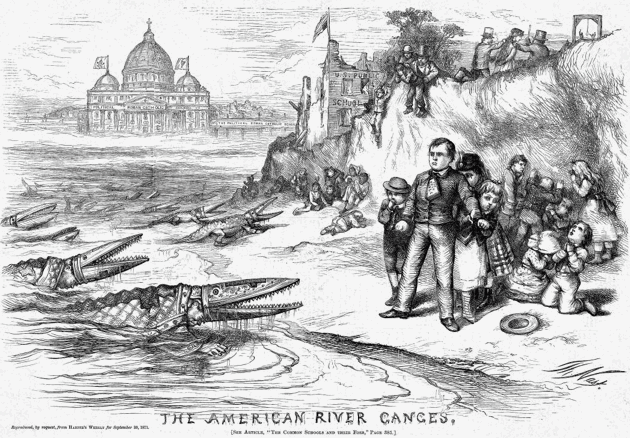As historians of American Catholicism, and Catholics, we are concerned to see the revival of a strain of nativism in the current controversy over the establishment of an Islamic center some blocks from Ground Zero in lower Manhattan.
For much of the nineteenth century Catholics in America were the unassimilated, sometimes violent “religious other.” Often they did not speak English or attend public schools. Some of their religious women—nuns—wore distinctive clothing. Their religious practices and beliefs—from rosaries to transubstantiation—seemed to many Americans superstitious nonsense.
Most worrisome, Catholics seemed insufficiently grateful for their ability to build churches and worship in a democracy, rights sometimes denied to Protestants and Jews in Catholic countries, notably Italy. In the 1840s and 1850s these anxieties about Catholicism in American society turned violent, including mob attacks on priests and churches as well as the formation of a major political party, the American Party, dedicated to combating Catholic influence. This led to novel claims that the US constitution demanded an absolute separation of church and state—claims that stem not from Thomas Jefferson and George Washington but from nineteenth-century politicians, ministers, and editors worried that adherents of a hierarchical Catholicism might destroy the hard-won achievements of American democracy. In 1875, a decade after accepting General Lee’s surrender at Appomattox, President Ulysses S. Grant publicly warned that Catholicism might prove as divisive in American society as the Confederacy.
Like many American Muslims today, many American Catholics squirmed when their foreign-born religious leaders offered belligerent or tone-deaf pronouncements on the modern world. New York’s own Bishop John Hughes thundered in 1850 that the Church’s mission was to convert “the officers of the navy and the Marines, commander of the Army, the legislatures, the Senate, the Cabinet, the president and all.” The Syllabus of Errors, promulgated by Pope Pius IX in 1864 denied that the Church had any duty to reconcile itself with “progress, liberalism, and modern civilization.”
But a Catholic president was elected in 1960, and today Catholics hold more seats in Congress than any other religious body. The Vice-President and Speaker of the House are Catholics, as are six of the nine Supreme Court justices.
It took Catholics more than a full century to attain their current level of acceptance and influence, and they made their share of mistakes along the way, occasionally by trying too hard to prove their patriotic bona fides. (Exhibit A: Senator Joseph McCarthy, whose name is now, paradoxically, a synonym for “un-American activities.”) But they earned their place, over the course of many decades, by serving (and dying for) their country, and building their own churches, schools and health care systems alongside public counterparts, which they also frequented and supported with their taxes.
Meanwhile, American Catholics helped transform parts of their own church that seemed at odds with the American freedoms they had come to cherish. An American Jesuit, John Courtney Murray, was decisive in shaping Dignitatis Humanae (1965)—the Declaration on Religious Liberty, in which the Second Vatican Council endorsed religious freedom for all people. In this sense, the American acceptance and encouragement of Catholic parishes and schools once seen as threatening, reshaped an international religious institution. The late Harvard political scientist Samuel Huntington once commented on how ironic it was that the papacy had become the greatest global champion of religious freedom in the final quarter of the twentieth century.
Historical comparisons are bound to be inexact; but American Muslims, like American Catholics, are now building their own religious and cultural institutions, and they are seeking guidance from a wide variety of religious sources—some few from jihadists, most from accommodationists.
Feisal Abdul Rauf, the imam at the center of the New York controversy, is an accommodationist. He claims, correctly, that the vast majority of the nation’s Muslims abhor al-Qaeda. Moreover, Rauf seeks to demonstrate that Muslims are no less Americans than are their Christian and Jewish counterparts. They, too, pray for (and were among) the victims of the September 11, 2001 terrorists and beg God’s forgiveness for atrocities committed in his name.
Is it imprudent for Rauf and his supporters to locate the proposed Islamic center so close to the site of terrible violence against Americans committed in the name of Islam? In fact the fault lies less with Rauf than with a debased effort to whip up partisan fervor around the issue. Must Muslims unequivocally reject all forms of terrorism—especially those Muslims who wish to promote full Muslim participation in American society? Of course. But if the Catholic experience in the United States holds any lesson it is that becoming American also means asserting one’s constitutional rights, fully and forcefully, even if that assertion is occasionally taken to be insulting. The genius of the American experiment in religious liberty is precisely this long-term confidence that equal rights for all religious groups builds the loyalty every democratic society needs. Certainly American Catholics learned that lesson long ago.
Advertisement
R. Scott Appleby is the John M. Regan, Jr. Director of the Kroc Institute for International Peace Studies at Notre Dame. John T. McGreevy is the I.A. O’Shaughnessy Dean of the College of Arts and Letters at the University of Notre Dame.


